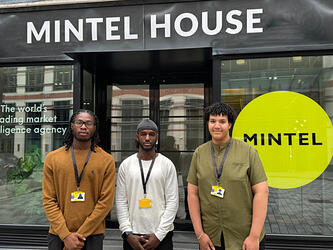Togetherness in a divided world
There is a deeply divisive figure in the White House, controversial wars are being fought abroad, the economy is stuttering, social cohesion is crumbling, and leaders around the world appear to be dangerously out of touch. Yet here is an iconic brand that promises optimism, togetherness and hope. A group of people – photogenic, but still reassuringly real – drawn together, bonded by the values displayed by a recognised label. At least that’s the plan.
It worked in 1971. The timeless ‘I’d Like to Buy the World a Coke’ campaign transformed the advertising and marketing industries because it promised something more than a simple consumerable. Here was a message of solidarity that appealed to a fractured society – an idealistic message of hope that permeated into a multinational, multi-ethnic psyche.
More than 45 years on, and society is almost an exact mirror image – yet, this time, the advertising doesn’t resonate as effectively. Inspired by the same youthful ‘them v us’, ‘love not war’ sentiment, Pepsi capitalised on progressive inner-city social movements to present itself as a similarly value-driven brand. It was a powerful, meaningful and important message, tarnished in the eyes of many because it featured a reality TV star whose privileged life is far removed from reality. Instead of inclusivity, it hinted at exclusivity.
What’s fascinating about these two campaigns is that Coke’s ‘Hilltop’ and Pepsi’s ‘Protest’ stood for unity and cohesion at a time of deep divisions in society. In both cases, the message of the brand is more important than what it actually is – a refreshing soft drink. The message is about togetherness in a divided world.
And that is what brands can do. Unite people by tapping into a collective cultural mood and reflecting a profound human truth – not always improved with the help of celebrities. Today, that ability to inspire is more vital than ever. Societies are fractured, divisions are widening, suspicions of political ‘others’ are heightened.
In recent years, our industry has agreed that a key responsibility of brands in such an uncertain period is to stand for something far beyond satiating consumer needs and accumulating profits. So we talk a lot about purpose. But do companies really mean it? Are they really living it? Can they demonstrate it; are they connecting with their audiences in an authentic, transparent and meaningful way – or are they just paying lip service to it? More importantly – at least from the viewpoint of market research – do today’s brands know their audiences well enough to craft these socially aware messages? Complacency has, for instance, ruined political careers in the past few years – leaders presume to know their key audiences, but they are using outdated methodologies to try to build robust connections.
The ultra-fast, hyper-linked nature of modern society means humans are less predictable than ever. Simple segmentation is no longer a sufficient measurement. People are being driven not by traditional subsets of differentiators, but by wildly random – yet personal – moments, feelings and experiences. And these moments are being shared, consumed and copied in a social-media instant by hugely disparate audiences.
There is an enormous opportunity for brands to unite us in a way that politicians and the media struggle to do – by reminding us of basic human truths and values, rather than becoming obsessed with laser-focused, narrow over-segmentation. Using social messages and moments that bring people together, that have emotional resonance, a fabulous sense of humour, and a loving recognition of the ordinariness of life.
Sometimes, these messages can have a societal purpose. P&G is currently running a great advert in India for one of its washing powders, Ariel, which encourages men to play a part in the household chores. It’s tackling a recognisable issue – in this case, deeply engrained sexist attitudes – and has the hashtag #sharetheload. On other occasions, such messages can be witty gifs that are instantly recognisable and shareable, or emotional touchpoints that relate to our everyday lives. Or they may link us all to an issue and mood that is part of the social zeitgeist. Barclays, for instance, is now talking about technical issues and protection from fraud, rather than simply how wisely our money can be spent and saved.
Meanwhile, Airbnb’s phenomenally successful recent campaign focused on freedom, choice, generosity and openness of spirit – everyday values we can all share in; simple cultures that we all want to be a part of. Multiple winners at this year’s Cannes Lions festival shared the everyday extraordinariness and emotional connections with which we can all identify. For example, the defiance of Fearless Girl (State Street Global Advisors), the joy of sharing sporting moments among impoverished communities (AP Thailand), the simple truth about what clean clothes (Whirlpool) can do to schoolchildren’s self-esteem.
What these examples demonstrate is breadth of impact. Precision targeting is useful, but the context in which we’re now operating is different. Things are tough and uncertain; our leaders and major companies are no longer infallible and we’re not as socially cohesive as we once were. In 1971, Coke bonded disparate cultures with something as simple as a song, a smile, a beautiful backdrop and the promise of happiness. It connected people with simple truths.
Today, that desire to connect is stronger than ever – and the responsibility of brands to forge these connections is greater than ever. We share similar values, our experiences are familiar to each other, our emotions are universal, the everyday events of our lives are still things that can bind us. Championing issues is not the only way to build connections among disparate audiences: owning heart-warming, funny and familiar everyday moments is, too.
When people feel divided and separated, it may be that focusing on the things that we can all relate to – ordinary people doing real things in their lives – may be even more powerful for brands than trying to change the world through a grand gesture.
What’s certain is that both strategies need to be built around optimism. The world needs it now as much as it did in 1971. Call me a sentimental softie if you must, but I sometimes yearn for the feel-good, simple moments in life – such as encountering apple trees and honey bees and snow-white turtle doves…
Vanella Jackson is chief executive at Hall and Partners

We hope you enjoyed this article.
Research Live is published by MRS.
The Market Research Society (MRS) exists to promote and protect the research sector, showcasing how research delivers impact for businesses and government.
Members of MRS enjoy many benefits including tailoured policy guidance, discounts on training and conferences, and access to member-only content.
For example, there's an archive of winning case studies from over a decade of MRS Awards.
Find out more about the benefits of joining MRS here.











0 Comments